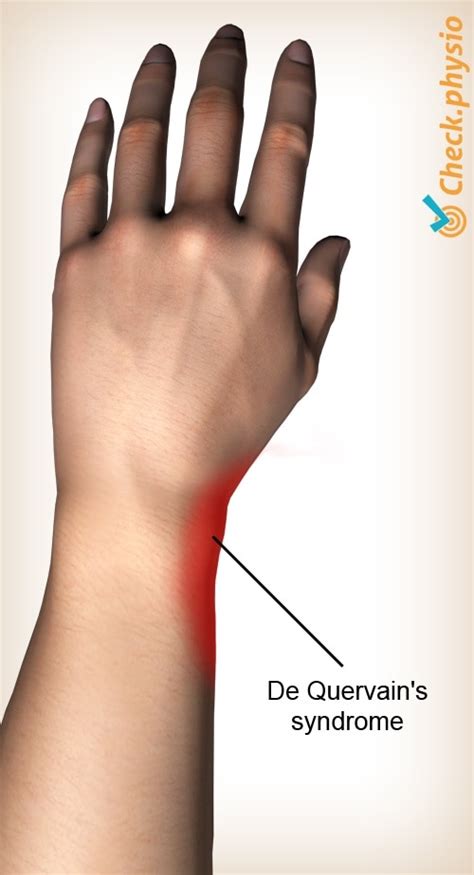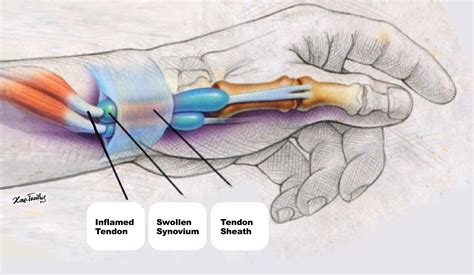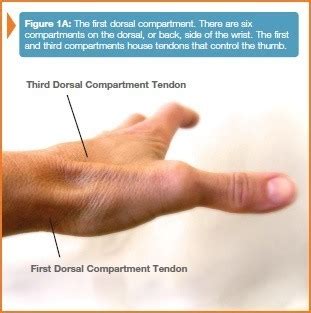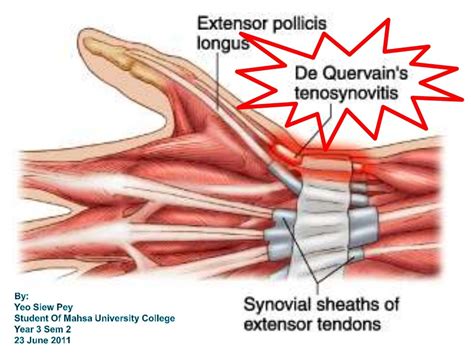Intro
Discover De Quervain Syndrome symptoms, causes, and treatments. Learn about wrist tendonitis, thumb pain, and swelling, and find relief from this repetitive strain injury affecting tendons and joints, causing discomfort and limited mobility.
De Quervain syndrome, also known as De Quervain tenosynovitis, is a condition that affects the tendons on the thumb side of your wrist. It occurs when the tendons around the base of the thumb are irritated or constricted, leading to pain and tenderness, especially when forming a fist, grasping, or turning the wrist. Understanding the symptoms of De Quervain syndrome is crucial for early diagnosis and treatment, which can significantly improve the quality of life for those affected.
The symptoms of De Quervain syndrome can vary from person to person but typically include pain and tenderness, especially on the thumb side of the wrist. This pain can radiate up the forearm and may worsen with activities that involve twisting or moving the wrist. Another common symptom is swelling in the affected area, which can lead to a noticeable lump or thickening of the tendons. People with De Quervain syndrome may also experience limited mobility or stiffness in the thumb and wrist, making everyday activities challenging.
De Quervain syndrome can result from a variety of factors, including repetitive strain, direct injury to the wrist or thumb, and certain types of activities or professions that involve repetitive motions of the wrist and thumb. For instance, individuals who frequently use their wrists and thumbs in a repetitive manner, such as gamers, musicians, or those involved in manufacturing or construction, are at a higher risk of developing De Quervain syndrome. Furthermore, the condition can also be associated with underlying health conditions like rheumatoid arthritis or diabetes. Recognizing these risk factors and understanding the symptoms can help in seeking medical attention early, which is vital for effective management and recovery.
Understanding De Quervain Syndrome

Understanding De Quervain syndrome involves knowing its causes, symptoms, and how it affects the body. The condition is named after the Swiss surgeon who first described it, Fritz de Quervain. It involves the tendons of the thumb, specifically the extensor pollicis brevis (EPB) and abductor pollicis longus (APL) tendons, which are surrounded by a sheath that reduces friction as they move. In De Quervain syndrome, the tendon sheath becomes inflamed, leading to pain and difficulty moving the thumb.
Clinical Presentation
The clinical presentation of De Quervain syndrome can vary, but the most common complaint is pain on the thumb side of the wrist, which can be exacerbated by certain movements. A physical examination may reveal tenderness and swelling over the affected tendons. The Finkelstein test is a diagnostic maneuver that involves making a fist with the thumb inside and then bending the wrist toward the little finger. If this movement reproduces the pain, it is often indicative of De Quervain syndrome.Symptoms and Diagnosis

The symptoms of De Quervain syndrome can be similar to those of other conditions, making diagnosis somewhat challenging. However, a thorough medical history, physical examination, and sometimes imaging studies can help confirm the diagnosis. The symptoms typically include:
- Pain and tenderness on the thumb side of the wrist
- Swelling in the affected area
- Limited mobility or stiffness in the thumb and wrist
- A "catching" or "snapping" sensation when moving the thumb
Diagnosing De Quervain syndrome often involves a clinical evaluation, where the healthcare provider assesses the symptoms, performs a physical examination, and may use the Finkelstein test to confirm the diagnosis. In some cases, imaging tests like X-rays or MRI scans may be ordered to rule out other conditions that could be causing the symptoms.
Treatment Options
Treatment for De Quervain syndrome aims to reduce pain and inflammation, promote healing, and improve the function of the thumb and wrist. Conservative treatments are usually tried first and may include: - Rest, ice, compression, and elevation (RICE) to reduce pain and swelling - Immobilization with a splint to rest the thumb and wrist - Physical therapy to improve mobility and strength - Anti-inflammatory medications to reduce pain and inflammation - Corticosteroid injections to reduce inflammationIn severe cases where conservative treatments do not provide relief, surgery may be recommended to release the tendon sheath and reduce pressure on the tendons.
Prevention and Management

Preventing De Quervain syndrome involves avoiding repetitive strain on the wrist and thumb. For individuals whose work or hobbies involve repetitive motions, taking regular breaks, stretching, and maintaining proper posture can help reduce the risk. Wearing a wrist splint, especially during activities that involve repetitive wrist and thumb movements, can also provide support and reduce strain.
Managing De Quervain syndrome after diagnosis involves following the recommended treatment plan, which may include a combination of rest, physical therapy, and medication. Making lifestyle adjustments, such as avoiding activities that exacerbate the condition and incorporating exercises that strengthen the thumb and wrist, can also aid in recovery and prevent recurrence.
Complications and Outlook
If left untreated, De Quervain syndrome can lead to chronic pain and limited mobility in the thumb and wrist, significantly impacting daily activities and quality of life. Early diagnosis and treatment can prevent long-term damage and improve outcomes. In most cases, with appropriate management, individuals can recover fully and return to their normal activities without significant long-term effects.Living with De Quervain Syndrome

Living with De Quervain syndrome requires understanding the condition, its symptoms, and how to manage them effectively. This includes learning about the treatments available, making necessary lifestyle adjustments, and incorporating preventive measures into daily life. Support from healthcare professionals, family, and friends can also play a significant role in coping with the condition and improving overall well-being.
For individuals with De Quervain syndrome, maintaining a positive outlook and being proactive in managing the condition can make a significant difference in recovery and quality of life. This involves staying informed about the latest treatments, participating in physical therapy, and adopting healthy habits to reduce the risk of flare-ups.
Future Directions
Research into De Quervain syndrome is ongoing, with a focus on better understanding the causes, improving diagnostic techniques, and developing more effective treatments. Advances in medical technology and a greater understanding of the condition at the molecular level may lead to new therapeutic options in the future. For now, early recognition of symptoms and timely intervention remain key to managing De Quervain syndrome effectively.Conclusion and Next Steps

In conclusion, De Quervain syndrome is a condition that affects the tendons on the thumb side of the wrist, leading to pain, tenderness, and limited mobility. Understanding the symptoms, causes, and treatment options is crucial for effective management. By taking preventive measures, seeking early medical attention, and following a comprehensive treatment plan, individuals can recover from De Quervain syndrome and improve their quality of life.
If you or someone you know is experiencing symptoms of De Quervain syndrome, it's essential to consult with a healthcare provider for proper diagnosis and treatment. With the right approach, it's possible to manage the condition, reduce pain, and regain full use of the thumb and wrist.
What are the primary symptoms of De Quervain syndrome?
+The primary symptoms include pain and tenderness on the thumb side of the wrist, swelling, and limited mobility or stiffness in the thumb and wrist.
How is De Quervain syndrome diagnosed?
+Diagnosis involves a clinical evaluation, including a medical history, physical examination, and sometimes imaging studies. The Finkelstein test is often used to confirm the diagnosis.
What are the treatment options for De Quervain syndrome?
+Treatment options include conservative approaches like rest, ice, compression, elevation, immobilization, physical therapy, and anti-inflammatory medications. In severe cases, corticosteroid injections or surgery may be recommended.
Can De Quervain syndrome be prevented?
+Prevention involves avoiding repetitive strain on the wrist and thumb, taking regular breaks, stretching, maintaining proper posture, and wearing a wrist splint during activities that involve repetitive motions.
What is the outlook for individuals with De Quervain syndrome?
+With early diagnosis and appropriate treatment, most individuals can recover fully and return to their normal activities without significant long-term effects.
We hope this comprehensive guide to De Quervain syndrome has provided you with valuable insights and information to better understand and manage the condition. If you have any further questions or would like to share your experiences with De Quervain syndrome, please don't hesitate to comment below. Your feedback and stories can help others who may be going through similar challenges. Additionally, consider sharing this article with anyone you know who might benefit from this information, as awareness and support are key to coping with De Quervain syndrome effectively.
